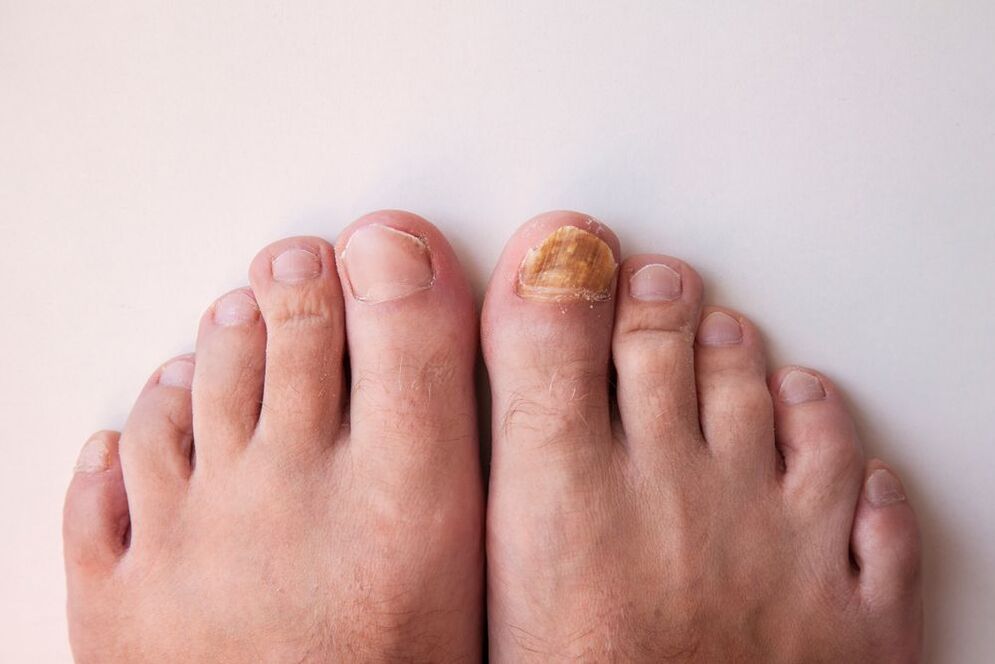Fungus (mycosis) of the feet– Fungal infections of the skin of the feet, interdigital folds, and nails caused by pathogenic fungi and conditionally pathogenic fungi. Conditional pathogens are natural inhabitants present in the normal microflora of the skin and mucous membranes in small quantities, however, under certain conditions, fungi begin to acquire pathogenic properties (causedisease) and cause disease. Regardless of the pathogen, the disease has similar symptoms and treatments.

In 9 out of 10 cases, the cause of athlete's foot is fungi of the genus Trichophyton. According to statistics, men are at higher risk of developing fungal infections of the feet than women. Men account for nearly 58% of all cases. Nail fungus (onychomycosis) most often develops on the III-IV nail plates of the feet. Often, nail fungus that is not treated long-term will become the cause of foot fungus and vice versa. It should be noted that some non-fungal skin diseases can be complicated by the presence of fungal diseases. Eczema on the feet is often associated with fungal diseases.
Symptoms of foot fungus

Athlete's foot
Tinea pedis (tinea pedis) is the most common fungal disease of the feet and nails. Fungal processes on the feet, as a rule, starting with damage to the side surfaces. Peeling (peeling) of the skin may occur. This process is not always accompanied by discomfort, itching or pain.
Over time, hyperkeratosis develops -thickened skin. Sometimes you may notice a slight redness of the skin, accompanied by a feeling of discomfort.flaky powder, giving the skin a powdery appearance. The skin may be dry, itchy, and sore. If the fungal infection is not treated at this stage, after a while, diaper rash will appear in the spaces between the fingers. Typically, the interdigital form of athlete's foot affects the folds between the third and fourth toes, and the fourth and fifth toes. Skin defects may form, characterized by a violation of its integrity (erosion) and painful cracks. With the interstitial (interstitial) form, symptoms of pronounced itching and sometimes burning of the affected skin appear.
INneglected formAthlete's foot occurs with formations on the surface of the fingersballoonfilled with clear fluid and covered with a thick horny layer. "Sago particles" (bubbles) may be single or fused into multichambered bubbles. When pyococci (purulent bacteria) are involved, the contents of the vesicles become cloudy, then they open and form ulcers, covered with purulent hemorrhagic crusts. There may be lymphadenitis and general deterioration of health.
When blisters appear, it is important not to confuse a fungal infection with dyshidrotic eczema. Only a doctor can understand the problem and make the correct diagnosis! In 2/3 of patients with athlete's foot in digital and progressive forms, mycids (allergic rashes) are observed.
Of course, the identification of clinical forms is conditional, since their combination often occurs - one form can transform into another. It all depends on the body's reaction, physical activity and treatment methods of the patient.
In addition, with athlete's foot, the nails are often affected, mainly on the first and fifth toes. The nail plate has yellow spots or stripes, the surface becomes dull and uneven, a thick horny layer begins to appear under the nail, which then leads to destruction of the nail plate.
Yeast-like athlete's foot
Recently, fungal infections of the feet caused by fungi of the genus Candida have become common. It is thought that this is due to the widespread use of antibiotics and cytostatics (anti-cancer drugs).
Mushroomgenus Candida, deposited in the interdigital folds, causing symptoms similar to scratches and diaper rash on the skin. Usually all digital spaces are involved in the skin process. Pain and burning of the skin between the toes occurs. Nail fungus (Candida infection) is more common on the hands of women - housewives, laundresses, dishwashers, food distributors in canteens. The nail plates become loose, peel and white spots appear.
Mold on feet
Mold is mainly common in countries with a tradition of walking barefoot (India, African countries). In regions with a temperate climate, this type of fungal disease also occurs, but as a rule, in immunocompromised patients and in people with frequent contact with soil and plants. The color of the nail plate will depend on the specific type of pathogen. The nail plate may even turn black.
However, when painting nails in this way, it is important not to miss the malignant form of finger skin tumors -Subungual melanoma.It is imperative to see a doctor for an accurate diagnosis!Often, fungal changes in the skin of the feet and nails can occur simultaneously. On the one hand, this can be seen as confirmation of the general nature of the fungus, on the other hand, it can mask other skin problems.
A change in the color or thickness of the nail plate does not necessarily indicate onychomycosis (onychomycosis). Nails can be damaged by trauma, wearing tight shoes, using poor quality polish or bacterial infection. For example, the nail plate is green due to Pseudomonas aeruginosa infection. However, colors such as yellow-brown, gray, or white will suggest fungal disease and require laboratory diagnosis. In addition, the thickness of the nail with a fungal infection can remain normal or, on the contrary, become very thin.
Causes of foot fungus
The main reasons for the development of fungal infections of the feet are:
- Increased sweating in the feet.
- Presence of chronic diseases.Diabetes mellitus, certain blood diseases, long-term use of antibiotics or immunosuppressants (immunosuppressants) contribute to the development of fungal infections and their spread to other parts of the body.
- Presence of microtraumas on the legs.Small cracks and cuts are a direct route of infection. Therefore, it is very important to immediately treat damaged skin areas with antiseptics.
- Failure to comply with hygiene rules.Walking without shoes in public places (bathrooms, saunas, swimming pools) is very susceptible to fungal infections.
Foot fungus treatment cream
Thanks to its special chemical structure, the drug has a triple effect on fungi: it helps stop their growth, reproduction and death, as well as prevents the transformation of fungi into a pathogenic form. Sertaconazole also has good lipophilicity (ability to dissolve in the fatty structure of cells). This ensures quick and effective penetration of the drug into the skin and enhances the local antifungal effect. At the same time, the development of resistance of fungal infections to treatment methods is practically not observed. The drug has an antibacterial effect against streptococci and staphylococci, reduces itching and inflammation.
So, the advantages of the cream are:
- Broad spectrum of antifungal effects
- Acts three times on fungal cells
- Reduces itching, inflammation and has antibacterial effects
- Good penetration into affected skin areas and long-lasting antifungal effect due to lipophilicity
- May be used during pregnancy and lactation if the expected benefits to the mother outweigh the possible risks to the fetus
The drug has an antibacterial effect against streptococcus and staphylococcus, reduces itching and inflammation.
Application of cream
For fungal infections of the feet, a thin layer should be applied to the affected skin, covering 1 cm of healthy skin 1-2 times a day for 2-4 weeks. Has three effects: antifungal, anti-itch, anti-inflammatory
Prevent foot fungus
To prevent fungal infections of the feet and nails, you must adhere to the following precautions:
- Disinfect shoes during treatment of foot fungus
- Maintain personal hygiene, do not walk barefoot in public places (swimming pools, saunas, bathrooms)
- Don't wear other people's shoes
- Choose shoes according to the season and preferably from natural materials.
- Treat fresh wounds and cuts promptly
- Use products to reduce foot sweat
Answer to the question
Is it possible to get a fungal infection again?
Reply:Yes you can. Previous fungal skin diseases do not cause long-term immunity. So you can get an unlimited number of fungal infections.
What is better to use to treat fungus: pills or creams and ointments?
Reply:The treatment regimen is determined only by the attending physician. This takes into account the severity and extent of the fungal infection. As a rule, fungal infections of the feet and nail plates are treated with local (external) agents.

























